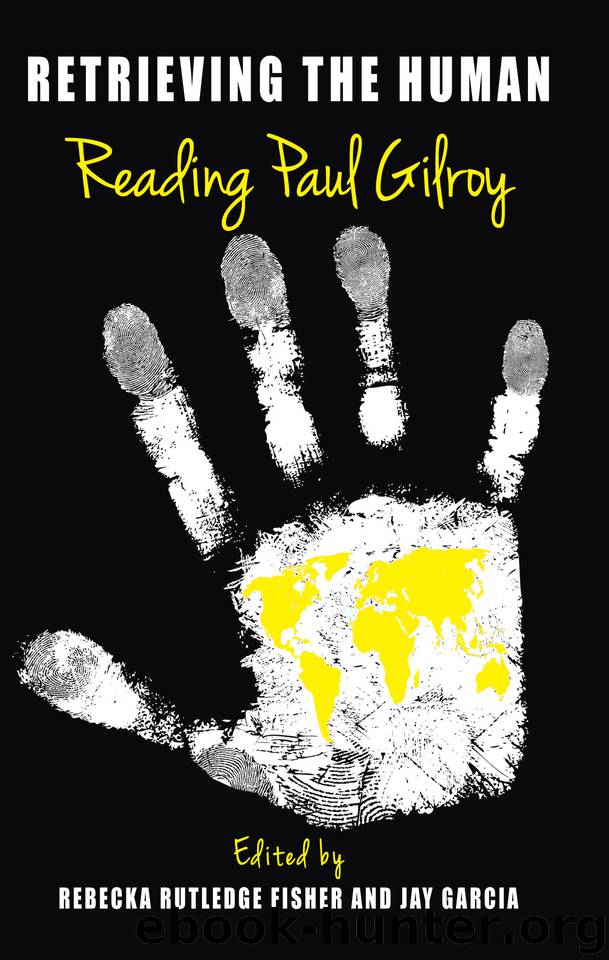Retrieving the Human: Reading Paul Gilroy (SUNY series, Philosophy and Race) by Rebecka Rutledge Fisher

Author:Rebecka Rutledge Fisher [Rebecka Rutledge Fisher]
Language: eng
Format: epub
Publisher: State University of New York Press
Published: 2014-08-20T16:00:00+00:00
Notes
1 . As captured, for example, by Markha Valenta’s stunning formulation: “[I]t is the continuing resonance of Europe’s bestial impulses half a century ago that today spurs Europe’s continued resistance to engaging fully the most fundamental challenges it faces.” “How to Recognize a Muslim,” in Political Theologies: Public Religions in a Post-Secular World , ed. Hent de Vries and Lawrence E. Sullivan (New York: Fordham University Press, 2006), 444–74; 464. It is important to recognize that this can be true and it can also be true that the colonial plantation was a key training ground for the administration of the Nazi camp.
2 . “We must think, know, represent for ourselves, formalize, judge the possible complicity among all these discourses and the worst (here the ‘final solution’).” Jacques Derrida, “Force of Law,” in Acts of Religion , ed. Gil Anidjar (Routledge: New York and London, 2002), 298.
3 . See my recent The Unconverted Self: Jews, Indians, and the Identity of Christian Europe (Chicago: University of Chicago Press, 2009).
4 . See, for example, Andrew Benjamin, “Particularity and Exception: On Jews and Animals,” South Atlantic Quarterly 107, 1 (2008): 71–87.
5 . A conundrum acutely addressed by Judith Butler, Bodies That Matter: On the Discursive Limits of “Sex” (New York: Routledge, 1993).
6 . See Jon Stratton, Coming Out Jewish: Constructing Ambivalent Identities (London: Routledge, 2000), for the argument that Jewish assimilation in liberal democracies consists in a semi-coerced surrender of Jewish endogamy for the larger endogamy of the racialized “white” majority population.
7 . For a more ambivalent reading of this quote, see Bryan Cheyette, “Frantz Fanon and Jean-Paul Sartre: Blacks and Jews,” Wasafiri 20 (2005): 7–12.
8 . Laura Chrisman, “The Vanishing Body of Frantz Fanon.” Symposium presentation in possession of author.
9 . Quoted in William Connolly, Why I Am Not a Secularist (Minneapolis: University of Minnesota Press, 2000), 49–50.
10 . Gilroy, After Empire , 88.
11 . Paul Gilroy, “Could You Be Loved? Bob Marley, Anti-Politics and Universal Sufferation,” Critical Quarterly 47 (2005): 226–245; 242.
12 . Chrisman, “The Vanishing Body,” 14.
13 . Paul Gilroy, The Black Atlantic (Cambridge Harvard University Press, 1993), 76.
14 . Paul Gilroy, “Multiculture in Times of War,” inaugural address at the London School of Economics, 2006, 35.
15 . Ibid., 39.
16 . Gilroy, “Could You Be Loved?” 241.
17 . See Stuart Hall, “Cultural Identity and Difference,” in Community, Culture, and Difference , ed. J. Rutherford (London: Lawrence & Wishart, 1990), 222–37.
18 . I do want to suggest nevertheless that New York City, as I experienced it from the late 1970s on, was and has been not “multicultural” but convivial. I can’t speak for New Haven—or Chapel Hill, for that matter. A great example, and consistent with Gilroy’s salutary emphases in both of his recent essays on multiculturalism on the intersection between commerce and conviviality, is the Domino’s New York–style pizza commercial with the lady passenger saying, “Fold it like a man!” and the immigrant, possibly Middle Eastern, driver saying, “I am folding it like a man!”
19 . I refer in particular here to its evocation at page 241 of “Could You Be Loved?”
20 .
Download
This site does not store any files on its server. We only index and link to content provided by other sites. Please contact the content providers to delete copyright contents if any and email us, we'll remove relevant links or contents immediately.
| General | Discrimination & Racism |
Nudge - Improving Decisions about Health, Wealth, and Happiness by Thaler Sunstein(6634)
iGen by Jean M. Twenge(4702)
The Fire Next Time by James Baldwin(4343)
Adulting by Kelly Williams Brown(3671)
The Sports Rules Book by Human Kinetics(3589)
The Hacking of the American Mind by Robert H. Lustig(3580)
The Ethical Slut by Janet W. Hardy(3504)
Captivate by Vanessa Van Edwards(3298)
Mummy Knew by Lisa James(3168)
In a Sunburned Country by Bill Bryson(2948)
Ants Among Elephants by Sujatha Gidla(2925)
The Worm at the Core by Sheldon Solomon(2918)
Suicide: A Study in Sociology by Emile Durkheim(2610)
The Slow Fix: Solve Problems, Work Smarter, and Live Better In a World Addicted to Speed by Carl Honore(2574)
Humans of New York by Brandon Stanton(2379)
Handbook of Forensic Sociology and Psychology by Stephen J. Morewitz & Mark L. Goldstein(2377)
Blackwell Companion to Sociology, The by Judith R. Blau(2319)
The Happy Hooker by Xaviera Hollander(2274)
Outliers by Malcolm Gladwell(2258)
